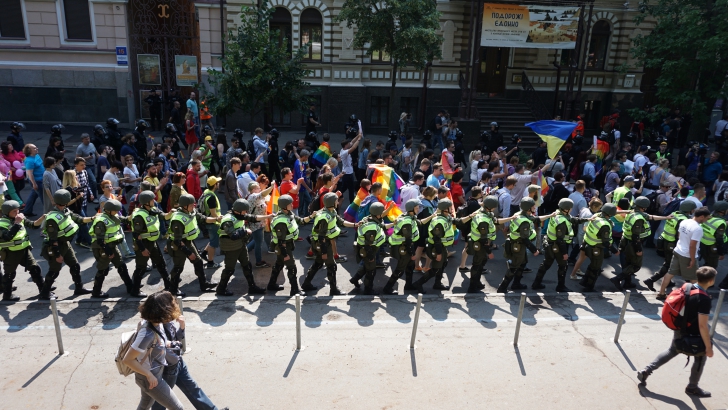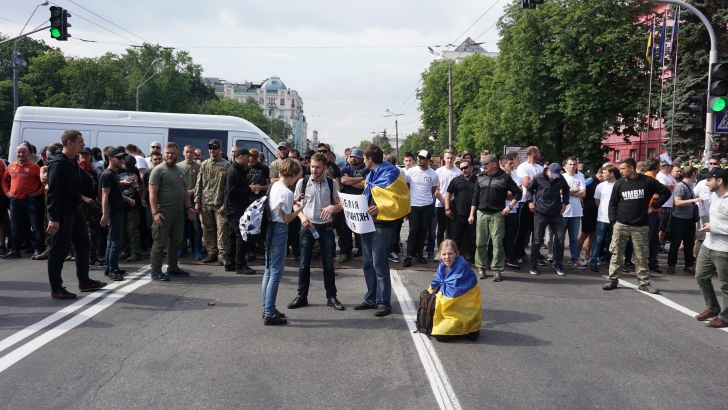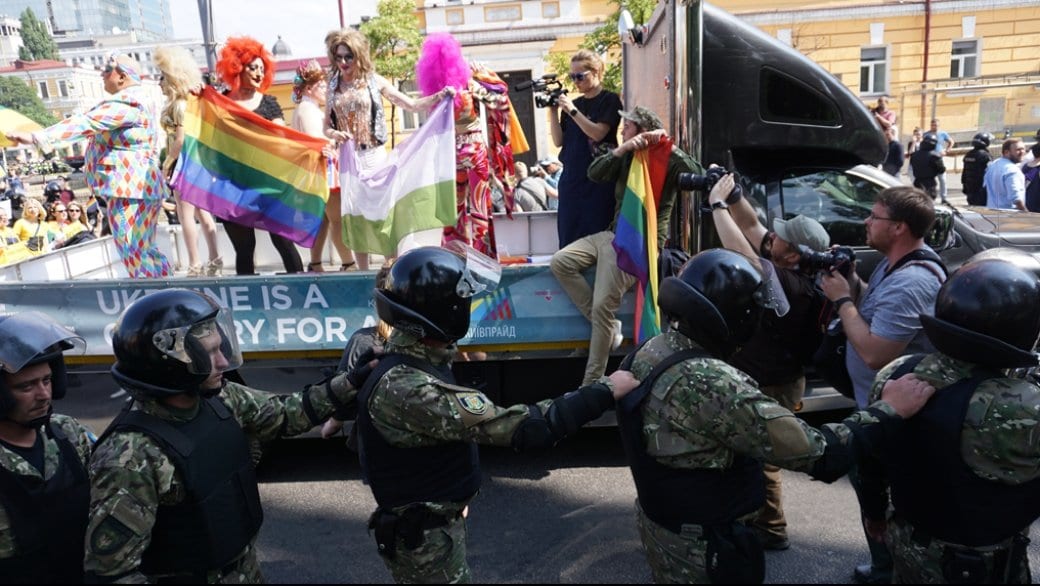About 300 anti-LGBT protesters banded into a line across the road a few hundred metres from where the city’s largest-ever Pride march — the second to take place in Kyiv’s city centre — was about to kick off. Most of them were men from the ultra-nationalist group Right Sector, some of whom burned a Pride flag in front of television cameras.
One protester told Ukrainian news agency UNIAN that the marchers “are planning to introduce tolerance classes in schools! What does it mean?”
“Say, if I’ll tell my son that this guy is a faggot, he’ll be like, ‘Dad, oops, you shouldn’t be saying such words.’”
Their chants got louder and angrier as the march time approached. Some of them started huffing and locking arms, expecting a charge from the police and National Guard members pooled nearby. When the march down the road still hadn’t moved a few minutes past its scheduled start time, some of the protesters looked as if they were wondering if they’d won.
Then the march started to inch forward. Many of the protesters looked dumbfounded as police moved swiftly to box them in.
Protected by a police cordon, the marchers took a left at the first intersection and went down a different street, avoiding the protesters altogether.
As the march took its own path, the protesters’ frowns and angry chants were replaced by whistles and cheers of “We’re different, we’re equal,” and “Ukraine for all.” There were colours, costumes and, for the first time at a KyivPride march, a crew of drag queens who’d come to the capital from all across Ukraine. If anyone here was afraid, it didn’t show.

KyivPride organizers estimated up to 4,000 marchers attended this year, more than twice as many as 2016, though Kyiv police estimated there were only 2,500 participants in the march. The march was much more diverse this year, with different LGBT communities — including Russian LGBT activists there in solidarity — and straight allies and foreign ambassadors including Canada’s ambassador to Ukraine, Roman Waschuk, marching alongside each other.
“This was what a real march of equality should look like,” KyivPride organizing committee member Anna Dovgopol told Ukraine’s Hromadske International.
The march wouldn’t have been successful without the work of more than 5,000 police officers and National Guard members, who flanked participants along the entire route and directed them to a metro station where they could be safely shuttled out of the city centre and away from the protesters.
For Ukrainian journalist and longtime LGBT activist Maxim Eristavi, this year’s Pride was “outstanding.”
“To finally feel that cheerful, violence-free, party-like mood for the first time ever was liberating,” he tells Xtra.
But Eristavi and other LGBT Ukrainians haven’t always felt this way. Surveys show that anti-LGBT attitudes are still strong in Ukraine. A 2016 survey showed that 60 percent of Ukrainians are generally negative towards LGBT people, and only four percent have positive attitude towards them. A recent Pew Research Center survey showed that 83 percent of Ukrainians think homosexual behaviour is “morally wrong” — among some of the highest in central and eastern Europe.
KyivPride board member Aleksandra Nazarova remembers how difficult it was to organize an LGBT march in the city five years ago. LGBT organizers were rebuffed by Kyiv city staff when they sought a permit to march. The community organized a small press conference instead, but two of the organizers were “teargassed and beaten” in front of journalists, she tells Xtra.

In 2013, 80 people marched along a stretch of suburban road barely longer than a football field, while 2014’s Pride march was cancelled by authorities. The first post-revolution March of Equality was held well outside the city centre in 2015, when far-right hooligans attacked hundreds of marchers. One of them threw a firecracker packed with nails that seriously injured a police officer, while other marchers were kicked and beaten as they tried to flee to the nearest metro station more than a kilometre away.
Ukraine’s LGBT activists still regularly deal with threats and violence. One human-rights activist noted before the march that Ukrainian authorities have failed to properly investigate a number of threats and attacks on LGBT activists nor been able — or willing — to bring the perpetrators to justice. It didn’t let up before this year’s Pride march; the day before, several Ukrainian LGBT activists were emailed a crude mock-up of LGBT people being lynched and decapitated with pitchforks.
But Ukraine’s loud, violent far-right fringe wasn’t able to live up to its promise to disrupt the march. While 10 LGBT activists and participants were reportedly injured in attacks after the march — including an attack where protesters followed activists around town for several hours before allegedly pouncing on them at a metro station — it was far from the “bloodbath” that the far-right had suggested.
Despite the threats and ongoing prejudice, Ukraine’s LGBT community may be gaining supporters.
“It was in the past year that I saw particularly clearly that the aggression against us actually benefits us as well,” KyivPride board member Zoryan Kis told UNIAN.
“A lot of people came to the march precisely because there had been threats against us, so people came there to protest against this violence.”

 Why you can trust Xtra
Why you can trust Xtra


